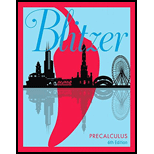
A television manufacturer makes rear-projection and plasma televisions. The profit per unit is $125 for the rear-projection televisions and $200 for the plasma televisions.
a. Let x= the number of rear-projection televisions manufactured in a month and let y= the number of plasma televisions manufactured in a month. Write the objective function that models the total monthly profit.
b. The manufacturer is bound by the following constraints:
• Equipment in the factory allows for making at most 450 rear-projection televisions in one month.
• Equipment in the factory allows for making at most 200 plasma televisions in one month.
• The cost to the manufacturer per unit is $600 for the rear-projection televisions and $900 for the plasma televisions. Total monthly costs cannot exceed $360,000
Write a system of three inequalities that models these constraints.
c. Graph the system of inequalities in part (b). Use only the first quadrant and its boundary, because x and y must both be nonnegative.
d. Evaluate the objective function for total monthly profit at each of the five vertices of the graphed region The vertices should occur at (0, 0). (0, 200). (300, 200).(450,100), and (450,0).|
e. Complete the missing portions of this statement: The television manufacturer will make the greatest profit by
manufacturing _______ rear-projection televisions each
month and _______ plasma televisions each month. The $$$
Want to see the full answer?
Check out a sample textbook solution
Chapter 7 Solutions
Precalculus (6th Edition)
- Please find all values of x.arrow_forward3. Consider the initial value problem 9y" +12y' + 4y = 0, y(0) = a>0: y′(0) = −1. Solve the problem and find the value of a such that the solution of the initial value problem is always positive.arrow_forward5. Euler's equation. Determine the values of a for which all solutions of the equation 5 x²y" + axy' + y = 0 that have the form (A + B log x) x* or Ax¹¹ + Bä” tend to zero as a approaches 0.arrow_forward
- 4. Problem on variable change. The purpose of this problem is to perform an appropriate change of variables in order to reduce the problem to a second-order equation with constant coefficients. ty" + (t² − 1)y'′ + t³y = 0, 0arrow_forward4. Some psychologists contend that the number of facts of a certain type that are remembered after t hours is given by f(t)== 90t 951-90 Find the rate at which the number of facts remembered is changing after 1 hour and after 10 hours. Interpret.arrow_forward12:05 MA S 58 58. If f(x) = ci.metaproxy.org 25 2xon [0, 10] and n is a positive integer, then there is some Riemann sum Sthat equals the exact area under the graph of ƒ from x = Oto x = 10. 59. If the area under the graph of fon [a, b] is equal to both the left sum L, and the right sum Rfor some positive integer n, then fis constant on [a, b]. 60. If ƒ is a decreasing function on [a, b], then the area under the graph of fis greater than the left sum Land less than the right sum R₂, for any positive integer n. Problems 61 and 62 refer to the following figure showing two parcels of land along a river: River Parcel 2 Parcel 1 h(x) 500 ft 1,000 ft. Figure for 61 and 62 61. You want to purchase both parcels of land shown in the figure and make a quick check on their combined area. There is no equation for the river frontage, so you use the average of the left and right sums of rectangles covering the area. The 1,000-foot baseline is divided into 10 equal parts. At the end of each…arrow_forward
- If a snowball melts so that its surface area decreases at a rate of 10 cm²/min, find the rate (in cm/min) at which the diameter decreases when the diameter is 12 cm. (Round your answer to three decimal places.) cm/minarrow_forward1) let X: N R be a sequence and let Y: N+R be the squence obtained from x by di scarding the first meN terms of x in other words Y(n) = x(m+h) then X converges to L If and only is y converges to L- 11) let Xn = cos(n) where nyo prove D2-1 that lim xn = 0 by def. h→00 ii) prove that for any irrational numbers ther exsist asquence of rational numbers (xn) converg to S.arrow_forward4.2 Product and Quotient Rules 1. 9(x)=125+1 y14+2 Use the product and/or quotient rule to find the derivative of each function. a. g(x)= b. y (2x-3)(x-1) c. y== 3x-4 √xarrow_forward
- 4.2 Product and Quotient Rules 1. Use the product and/or quotient rule to find the derivative of each function. 2.5 a. g(x)=+1 y14+2 √x-1) b. y=(2x-3)(x-:arrow_forward3. The total profit (in dollars) from selling x watches is P(x)=0.52x²-0.0002x². Find and interpret the following. a) P(100) b) P'(100)arrow_forward3. Find the slope and the equation of the tangent line to the graph of the given function at the given value of x. -4 f(x)=x-x³;x=2arrow_forward

 Elementary Geometry For College Students, 7eGeometryISBN:9781337614085Author:Alexander, Daniel C.; Koeberlein, Geralyn M.Publisher:Cengage,
Elementary Geometry For College Students, 7eGeometryISBN:9781337614085Author:Alexander, Daniel C.; Koeberlein, Geralyn M.Publisher:Cengage,
 Algebra for College StudentsAlgebraISBN:9781285195780Author:Jerome E. Kaufmann, Karen L. SchwittersPublisher:Cengage Learning
Algebra for College StudentsAlgebraISBN:9781285195780Author:Jerome E. Kaufmann, Karen L. SchwittersPublisher:Cengage Learning Glencoe Algebra 1, Student Edition, 9780079039897...AlgebraISBN:9780079039897Author:CarterPublisher:McGraw Hill
Glencoe Algebra 1, Student Edition, 9780079039897...AlgebraISBN:9780079039897Author:CarterPublisher:McGraw Hill College AlgebraAlgebraISBN:9781305115545Author:James Stewart, Lothar Redlin, Saleem WatsonPublisher:Cengage Learning
College AlgebraAlgebraISBN:9781305115545Author:James Stewart, Lothar Redlin, Saleem WatsonPublisher:Cengage Learning





